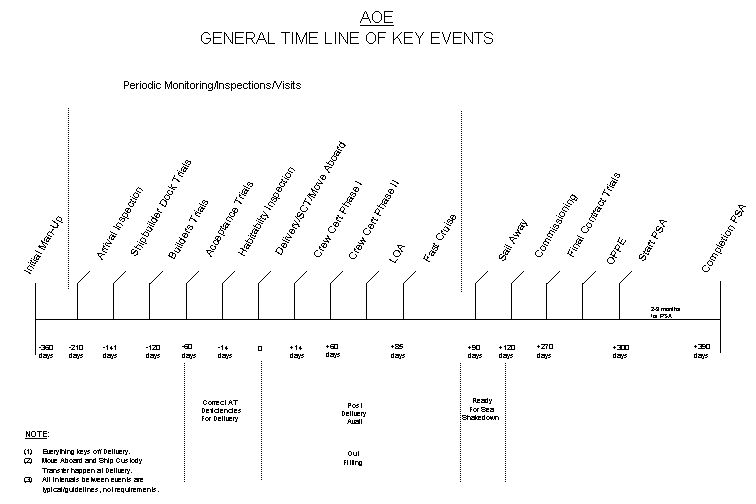
REFERENCES.
(a) NAVSEA S9086-C4-STM-000 - NSTM Chapter 094 (Trials)
(b) OPNAVINST 9080.3 - Procedures for Tests and Trials of Navy Nuclear Powered Ships Under Construction, Modernization, Conversion, Refueling and Overhaul
(c) OPNAVINST 4700.8 - Trials, Acceptance, Commissioning, Fitting-Out, Shakedown, and Post Shakedown Availability of U.S. Naval Ships Undergoing Construction or Conversion
(d) OPNAVINST 4790.4 - Ships' Maintenance and Material Management (3-M) Manual
LISTING OF APPENDICES.
A Summary of Typical New Construction Major Milestones and Message Reporting Requirements.
B General Time Lines of Key Events
C List of Acronyms
D Glossary of Terms
1.1 PURPOSE. Volume I of this manual summarizes maintenance related information for all units of the Fleet during Ship construction and through the completion of Post Shakedown Availability (PSA). The time span is from initial crew man-up to departure from the PSA facility.
1.2 SCOPE.
a. New Construction ships require a succession of inspections and tests followed by a series of underway trials. The philosophy and sequencing of these inspections, tests, and trials are set forth in references (a), (b), and (c) and are graphically represented in Appendices A and B of this chapter. This Volume provides information, guidance, policies and procedures for maintenance related topics during the Ship's construction period. Reference (d) shall be used in conjunction with the Joint Fleet Maintenance Manual to establish an effective maintenance program. The requirements of this manual do not supersede or take precedence over directives issued by higher authority. Where conflicts exist with previously issued Type Commander (TYCOM) letters and transmittals, this manual takes precedence. Conflicts should be reported to the applicable TYCOM.
b. The development of this and subsequent volumes to the Joint Fleet Maintenance Manual has required the study of numerous reference documents, many of which are referenced as source or governing documents in specific chapters. The Foreword of this Manual contains a Master Listing of all the references called out in the Joint Fleet Maintenance Manual. These references are arranged in an alpha/numeric sequence to facilitate the ordering of documentation to support the use of the Joint Fleet Maintenance Manual. References used in specific chapters are called out at the beginning of that chapter.
c. Appendices C and D of this chapter contain a list of acronyms and a glossary of terms used throughout Volume I of the Joint Fleet Maintenance Manual.
d. Equipment under the cognizance of the Strategic Systems Project Office or Naval Sea Systems Command (NAVSEA) Nuclear Propulsion Directorate (08) are maintained in accordance with Strategic Systems Project Office and NAVSEA 08 directives, respectively.
1.3 CHANGES AND CORRECTIONS. Changes and corrections will be issued as required. Comments and suggestions for improving or changing this volume are invited. Address comments, recommendations, and requested changes to Submarine Maintenance Engineering, Planning and Procurement (SUBMEPP) Activity utilizing the change request form located in the front of this manual. If changes are submitted in electronic format, facsimile or E-mail, each change request shall contain the information required on the change request form.
SUMMARY OF TYPICAL NEW CONSTRUCTION MAJOR
MILESTONES AND MESSAGE REPORTING REQUIREMENTS
|
Event |
Cognizance |
Approximate Schedule (see Note) |
|
A. Arrival Assist |
Immediate Superior in Command (ISIC) |
Crew Arrival +2 months |
|
B. Periodic Monitoring Inspections |
ISIC |
Start to completion |
|
C. Pre-Reactor Safeguard Examination (RSE) |
ISIC (TYCOM Assist) |
Criticality -6 to -8 weeks |
|
D. RSE per OPNAVINST 3540.3 |
Naval Sea Systems Command (NAVSEA) Nuclear Propulsion Directorate (08) |
Criticality -4 to -6 weeks |
|
E. Criticality |
Prospective Commanding Officer (PCO) | |
|
F. Escort Recommendation Message |
ISIC/Supervising Authority |
-60 days |
|
G. Phase I Crew Certification |
ISIC |
-35 days |
|
H. Salvage Inspection |
ISIC |
-30 days |
|
I. Habitability Inspection for In-Service per OPNAVINST 9080.3 |
ISIC |
-30 days |
|
J. Approve Sea Trial Agendas * * Only Alpha Trial Agenda is approved 30 days before trial date |
NAVSEA for Propulsion Trials; Director, Strategic Systems Programs for Ballistic Missile Trials; Board of Inspection and Survey (INSURV) for Acceptance Trial (AT); TYCOM for Operational Aspects all Trials |
-30 days |
|
K. In-Service per OPNAVINST 4700.8 and OPNAVINST 9080.3 |
Supervising Authority NAVSEA, ISIC and TYCOM |
-28 days |
|
L. Dock Trial |
Officer in Charge (OIC) |
-21 days |
|
M. Phase II Crew Certification Message (Volume I, Chapter 2, Appendix B1) |
ISIC |
-9 days |
|
N. Crew Certification Message (Volume I, Chapter 2, Appendix B2) |
TYCOM |
-8 days |
|
O. Readiness for Fast Cruise/Sea Trial Message (Volume I, Chapter 2, Appendix B3) |
Supervising Authority/OIC concurrence |
-7 days |
|
P. Certify Material Condition for Alpha Sea Trial Message (Volume I, Chapter 2, Appendix B6) |
NAVSEA |
-7 days |
|
Q. Authorize Commencement of Sea Trial Message |
TYCOM to ISIC to Ship |
-7 days |
|
R. Fast Cruise |
OIC |
-6 days (2 days on, 1 day off, 2 days on) |
|
S. Report Completion of Fast Cruise and Readiness for Sea Trial Message (Volume I, Chapter 2, Appendix B5) |
Supervising Authority (with OIC concurrence) to TYCOM |
-1 day |
|
T. Depth Authorization Message (Volume I, Chapter 2, Appendix B7) |
TYCOM |
-1 day |
|
U. Alpha Sea Trial |
OIC |
0 |
|
V. Readiness for Bravo Sea Trial Message (Volume I, Chapter 2, Appendix C1) |
Supervising Authority |
Bravo Sea Trial -1 day |
|
W. Readiness for Bravo Sea Trial Message (Volume I, Chapter 2, Appendix C2) |
NAVSEA |
Bravo Sea Trial -1 day |
|
X. Bravo Sea Trial Authorization Message (Volume I, Chapter 2, Appendix C3) |
TYCOM |
Bravo Sea Trial -1 day |
|
Y. Bravo Sea Trial |
OIC |
+3 days |
|
Z. Readiness for Charlie Sea Trial Message (Volume I, Chapter 2, Appendix C1) |
Supervising Authority |
Charlie Sea Trial -1 day |
|
AA. Readiness for Charlie Sea Trial Message (Volume I, Chapter 2, Appendix C2) |
NAVSEA |
Charlie Sea Trial -1 day |
|
AB. Charlie Sea Trial Authorization Message (Volume I, Chapter 2, Appendix C3) |
TYCOM |
Charlie Sea Trial -1 day |
|
AC. Charlie Sea Trial |
OIC |
+45 days |
|
AD. Readiness for INSURV Sea Trial Message (Volume I, Chapter 2, Appendix C1) |
Supervising Authority |
INSURV Sea Trial -1 day |
|
AE. Readiness for INSURV Sea Trial Message (Volume I, Chapter 2, Appendix C2) |
NAVSEA |
INSURV Sea Trial -1 day |
|
AF. INSURV Sea Trial Authorization Message (Volume I, Chapter 2, Appendix C3) |
TYCOM |
INSURV Sea Trial -1 day |
|
AG. INSURV |
Supervising Authority and OIC |
+60 days |
|
AH. Recommendation for Unrestricted Operations Certification Message (Volume I, Chapter 2, Appendix D1) |
Supervising Authority | |
|
AI. Unrestricted Operations Certification Message (Volume I, Chapter 2, Appendix D2) |
NAVSEA | |
|
AJ. Unrestricted Operation Authorization Message (Volume I, Chapter 2, Appendix D3) |
TYCOM |
Note: Unless otherwise indicated, scheduled dates are referenced to the Alpha Sea Trial underway date.
SUMMARY OF TYPICAL NEW CONSTRUCTION MAJOR
MILESTONES AND MESSAGE REPORTING REQUIREMENTS
|
Event |
Cognizance |
Approximate Schedule (see Note) |
|
A. Arrival Inspection | ||
|
B. Periodic Monitoring Inspections |
TYCOM |
Start to Completion |
|
C. Pre-RSE |
TYCOM | |
|
D. Habitability Inspection for In-Service per OPNAVINST 9080.3 |
TYCOM |
-180 days |
|
E. Phase I Crew Certification |
ISIC |
-120 days |
|
F. RSE per OPNAVINST 3540.3 |
NAVSEA 08 | |
|
G. Criticality |
PCO |
-90 and -60 days |
|
H. Approve Sea Trial Agenda |
NAVSEA (for Builder's Trials (BT)) INSURV (for AT) |
-70 days |
|
I. In-Service per OPNAVINST 4700.8 and OPNAVINST 9080.3 |
Supervising Authority, NAVSEA, TYCOM |
-65 days |
|
J. Dock Trial |
PCO |
-60 days |
|
K. Phase II Crew Certification Message |
ISIC |
-55 days |
|
L. Crew Certification Message |
ISIC |
-50 days |
|
M. Readiness for Fast Cruise/Sea Trial Message |
Supervising Authority, w/PCO concurrence |
-50 days |
|
N. Authorize Commencement of Sea Trial Message |
TYCOM |
-46 days |
|
O. Fast Cruise |
PCO |
-45 days |
|
P. Report Completion of Fast Cruise and Ready for Sea Trial Message |
Supervising Authority, w/PCO concurrence |
-40 days |
|
Q. Builder's Trials |
PCO |
-30 days |
|
R. Acceptance Trials |
PCO |
-21 days |
|
S. Readiness for Final Contract Trials (FCT) Message |
NAVSEA |
+59 days |
|
T. Final Contract Trials |
CO |
+60 days |
|
U. Operational Reactor Safeguard Examination (ORSE) |
NAVSEA 08 |
Note: Unless otherwise indicated, scheduled dates are referenced to the Delivery date.
(This Page Intentionally Left Blank)
SUMMARY OF TYPICAL NEW CONSTRUCTION MAJOR
MILESTONES AND MESSAGE REPORTING REQUIREMENTS
|
Event |
Cognizance |
Approximate Schedule (see Note) | ||||
|
AOE |
DDG |
LHD |
LPD/LSD |
MHC | ||
|
A. Arrival Inspection |
ISIC/TYCOM |
Crew Arrival | ||||
|
B. Periodic Monitoring Inspections |
ISIC/TYCOM |
Start To Completion | ||||
|
C. AEGIS Light-Off (If applicable) |
NAVSEA/Supervising Authority |
-300 days | ||||
|
D. Main Engine Light-Off |
NAVSEA/Supervising Authority |
-210 days | ||||
|
E. Builder's Dock Trial |
Supervising Authority |
-141 days |
-210 days |
-180 days | ||
|
F. Builder's Trial (Alpha) |
Supervising Authority |
-120 days |
-120 days |
-130 days |
-90 days | |
|
G. Builder's Trial (Bravo) "Combat Systems" |
Supervising Authority |
-60 days | ||||
|
H. Builder's Trial (Charlie) "Acceptance" |
Supervising Authority |
-60 days |
-30 days |
-60 days |
-90 days |
-30 days |
|
I. Habitability Inspection for In-Service per OPNAVINST 9080.3 |
ISIC |
-14 days |
-14 days |
-3 days |
-14 days |
-14 days |
|
J. Phase I Crew Certification |
ISIC |
+14 days |
-120 days |
+10 days | ||
|
K. Phase II Crew Certification |
ISIC |
+60 days |
+60 days |
+80 days |
+8 days |
+65 days |
|
L. Light-Off Assessment (LOA) |
ISIC/TYCOM |
+70 days |
-15 days |
+70 days |
+45 days |
+60 days |
|
M. In-Service per OPNAVINST 4700.8 "Delivery" |
NAVSEA/Supervising Authority/TYCOM |
0 |
0 |
0 |
0 |
0 |
|
N. Dock Trial |
PCO | |||||
|
O. Fast Cruise |
PCO | |||||
|
P. Commissioning |
CO |
+120 days |
+14 days |
+90 days |
+60 days |
+70 days |
|
Q. Sailaway |
CO |
+90 days |
+95 days |
+90 days |
+80 days | |
|
R. Final Contract Trials |
Supervising Authority |
+330 days |
+120 days |
+270 days |
+210 days |
+90 days |
|
S. Operational Propulsion Plant Examination (OPPE) |
ISIC/TYCOM |
+345 days |
+180 days |
+345 days |
+225 days |
+105 days |
|
T. Commence PSA |
Supervising Authority |
+360 days |
+420 days |
+240 days |
+120 days |
Note: Unless otherwise indicated, scheduled dates are referenced to the Delivery date.
(This Page Intentionally Left Blank)

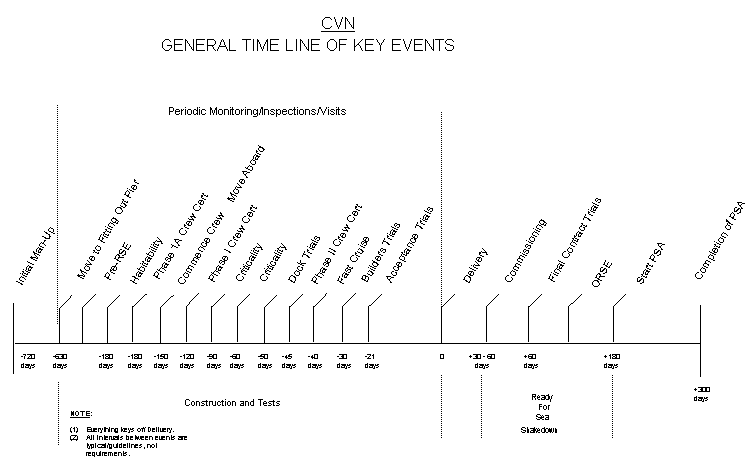
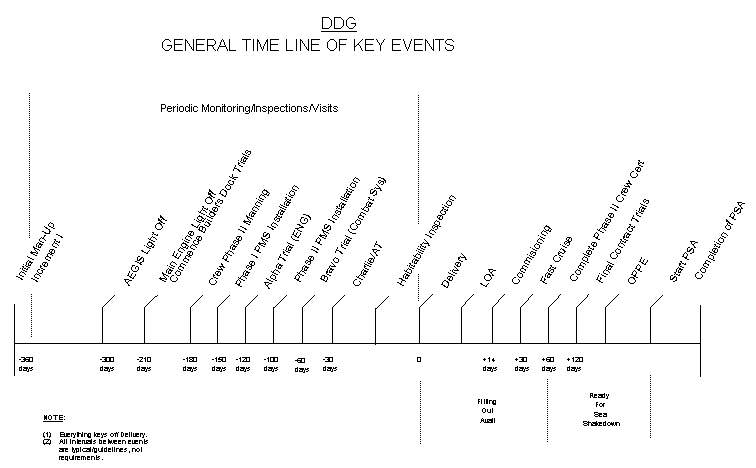
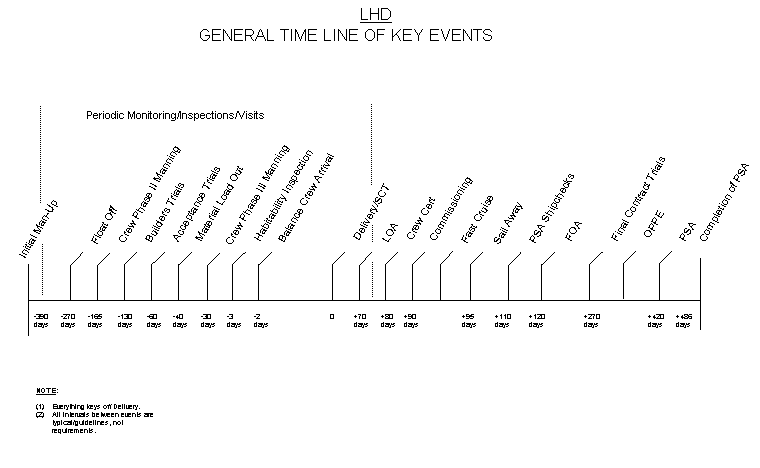
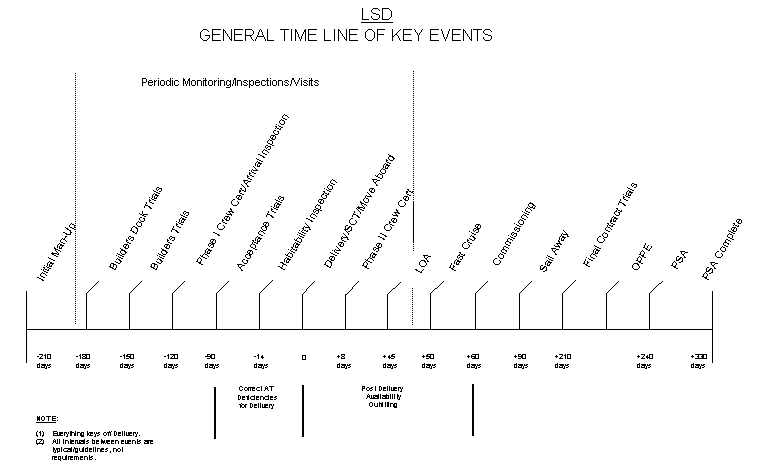
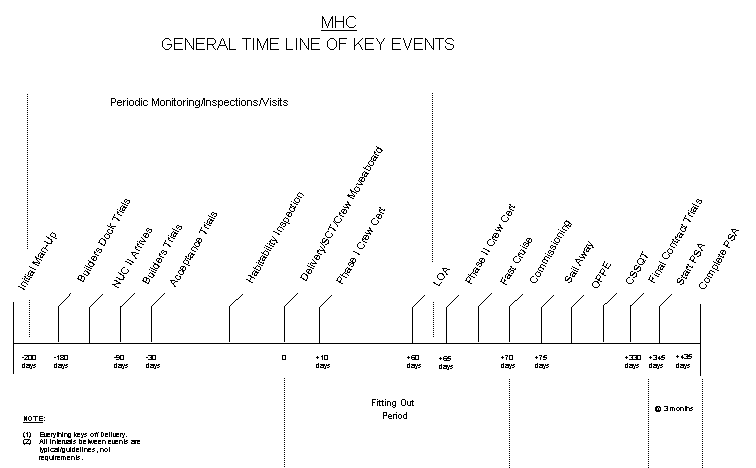
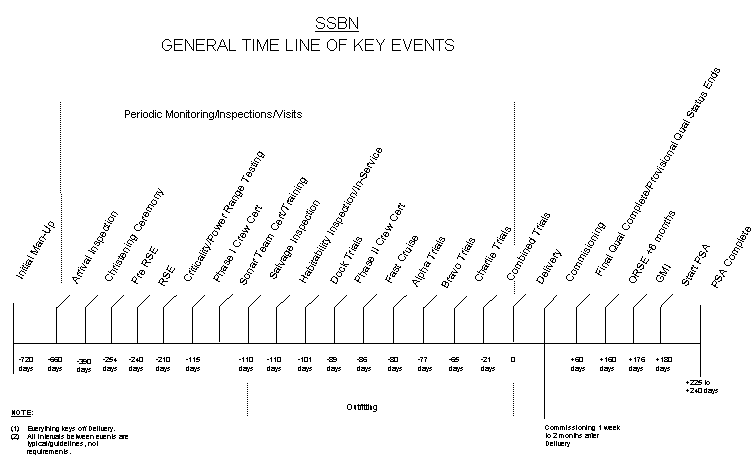
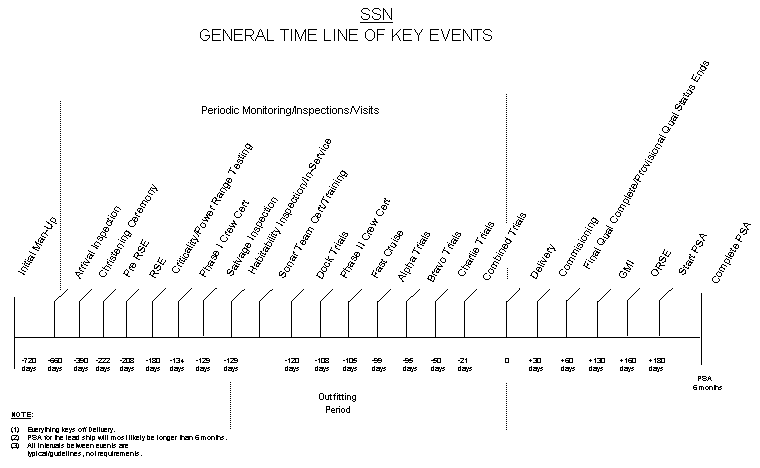
2M Miniature/Microminiature
3-M Maintenance and Material Management
A&I Alteration and Improvement
AEL Allowance Equipage List
AOE Fast Combat Support Ship
APL Allowance Parts List
ASW Antisubmarine Warfare or Auxiliary Seawater
AT Acceptance Trial
BDT Builder's Dock Trial
BST Builder's Sea Trial
BT Builder's Trial
BUPERS Bureau of Personnel
CAGE Commercial and Government Entity
CASREP Casualty Report
CD-ROM Compact Disc Read Only Memory
CFE Contractor Furnished Equipment
CHT Collection, Holding and Transfer
CINCLANTFLT Commander in Chief, Atlantic Fleet
CINCPACFLT Commander in Chief, Pacific Fleet
CNO Chief of Naval Operations
CO Commanding Officer
COMNAVSURFLANTCommander Naval Surface Force Atlantic
COMSUBDEVGRU Commander Submarine Development Group
COSAL Coordinated Shipboard Allowance List
CSCT Combat Systems Certification Trial
CSMP Current Ship's Maintenance Project
CSSQT Combat System Ship Qualification Trials
CT Combined Trial
CVN Nuclear-Powered Aircraft Carrier
CW Continuous Wave
DDG Guided Missile Destroyer
DIRSSP Director, Strategic Systems Programs
DRA Dead Reckoning Analyzer
DRAI Dead Reckoning Analyzer Indicator
DRT Dead Reckoning Tracer
DSRS Deep Submergence Rescue System
DSRV Deep Submergence Rescue Vehicle
EAB Emergency Air Breathing
EDORM Engineering Department Organization and Regulations Manual
EEBD Emergency Escape Breathing Device
EGL Equipment Guide List
EMBT Emergency Main Ballast Tank
EOSS Engineering Operational Sequencing System
EPM Emergency Propulsion Motor
ESM Electronic Warfare Support Measures
ETG Engineering Training Group
FCT Final Contract Trial
FIT Fleet Introduction Team
FLTCINC Fleet Commander in Chief
FMA Fleet Maintenance Activity
FMR Field Modification Request
FOSAT Fitting Out Supply Assistance Team
FOSSAC Fitting Out and Supply Support Assistance Center
FTC Fleet Training Center
FTSC Fleet Technical Support Center
FTSCLANT Fleet Technical Support Center Atlantic
FTSCPAC Fleet Technical Support Center Pacific
GFE Government Furnished Equipment
GFI Government Furnished Information
GMI Guarantee Material Inspection
GPETE General Purpose Electronic Test Equipment
HF High Frequency
HMR Headquarters Modification Request
IEM Inactive Equipment Maintenance
IFF Identification Friend or Foe
INSURV Inspection and Survey
ISE Independent Ship Exercise
ISEA In-Service Engineering Activity
ISIC Immediate Superior in Command
JSN Job Sequence Number
LHD Amphibious Assault Ship
LOA Light-Off Assessment
LOEP List of Effective Pages
LSD Dock Landing Ship
MACHALT Machinery Alteration
MBT Main Ballast Tank
METCAL Metrology and Calibration
MHC Coastal Minehunter
MIP Maintenance Index Page
MRC Maintenance Requirement Card
MRMS Maintenance Resources Management System
MSW Main Seawater
MT Magnetic Particle Testing
MTR Metrology and Calibration Technical Representative
NAVAIR Naval Air Systems Command
NAVMASSO Navy Management Systems Support Office
NAVSEA Naval Sea Systems Command
NAVSUP Naval Supply Systems Command
NAWC Naval Air Warfare Center
NJP Non-judicial Punishment
NSTM Naval Ships' Technical Manual
NSWC Naval Surface Warfare Center
NSWCCD Naval Surface Warfare Center Carderock Division
NTP Naval Telecommunication Procedures
O&MN Operations and Maintenance, Navy
OCT Operational Control Transfer
OIC Officer In Charge
OPNAV Office of Chief of Naval Operations
OPPE Operational Propulsion Plant Examination
ORDALT Ordnance Alteration
ORSE Operational Reactor Safeguard Examination
OSI Operating Space Item
OSS Operational Sequencing System
PCO Prospective Commanding Officer
PCU Pre-Commissioning Unit
PDDI Post Delivery Deficiency Item
PEO CLA Program Executive Office for Carriers, Littoral Warfare and Auxiliary
PERA Planning, Evaluation, Repair and Alterations
PMS Planned Maintenance System
POAM Plan of Action and Milestones
PQS Personnel Qualification Standard
PSA Post Shakedown Availability
QA Quality Assurance
RDORM Reactor Department Organization and Regulations Manual
RSE Reactor Safeguard Examination
RT Radiographic Testing
SCN Shipbuilding and Conversion, Navy
SDI Ship Drawing Index
SDOSS Sewage Disposal Operational Sequencing System
SHIPALT Ship Alteration
SIB Ship Information Book
SITREP Situation Report
SMMSO Submarine Systems Monitoring Maintenance and Support Office
SNAP Shipboard Nontactical Automated Data Processing Program
SOE Submerged Operating Envelope
SORM Ship Organization and Regulation Manual
SOSMRC Senior Officer Ship Maintenance and Repair Course
SPALT Strategic System Projects Office Alteration
SRD Selected Record Drawing
SSBN Nuclear-Powered Ballistic Missile Submarine
SSM Ship Systems Manual
SSN Nuclear-Powered Attack Submarine
SUBMEPP Submarine Maintenance Engineering, Planning and Procurement Activity
SUBSAFE Submarine Safety
SWOS Surface Officer Warfare School
TD Test Depth
TDU Trash Disposal Unit
TEMPEST National Policy on the Control of Compromising Emanations (unclassified code name)
TFBR Technical Feedback Report
TVD Technical Variance Documentation
TYCOM Type Commander
UHF Ultrahigh Frequency
URO Unrestricted Operations
VLS Vertical Launch System
VTI Visual TEMPEST Inspection
TERM DEFINITION
Alpha Trial Builder's Propulsion Trial; Acceptance Trial for SSN/SSBN Propulsion Plant; Initial Tightness Dive (SSN/SSBN); Dive to Maximum Authorized Depth (Selected SSN platforms)
Acceptance Trials (AT) Trials and material inspections conducted underway by the INSURV Board for ships constructed in a private industrial activity to determine suitability for acceptance of a ship by the Navy.
Accepting Authority The officer designated by the Chief of Naval Operations (CNO) to accept a vessel for the Navy, normally NAVSEA.
Bravo Trial Normally the initial Dive to Test Depth; Noise Trial (SSN/SSBN); Strategic Weapons System Missile Testing (SSBN); Weapons testing (Surface Combatants).
Builder's Trials (BT) Evaluation trials and inspections conducted underway by the builder to assure the builder and the Navy that the ship is, or will be, ready for Acceptance Trials. These trials should be a comprehensive test of all ship's equipment and be similar in scope to Acceptance Trials. For nuclear powered surface ships this is the Acceptance Trial for the Nuclear Propulsion plant.
Charlie Trial Combat Systems and retesting (SSN/SSBN); Acceptance Trials (DDG).
Combined Trials (CT)Combined Trials are a combination of an Acceptance Trial with a Final Contract Trial. The INSURV Board normally conducts Combined Trials for nuclear powered submarines.
Deep Dive The first dive to maximum operating depth. This depth will not necessarily coincide with the design test depth of the hull. See definition of Maximum Operating Depth.
Delivery The date the Navy accepts the ship from the shipbuilder. This requires a recommendation from the INSURV Board to accept/deliver the ship. Delivery of the ship is based on Acceptance Trials and satisfactory correction or resolution of deficiencies.
Dock Trial Dock Trials are those ship trials conducted at the Industrial Activity to determine the ability of the ship, from a material standpoint, to conduct Sea Trials safely.
Fast Cruise A period immediately prior to underway trials during which Ship's Force operates the ship for dockside training. Fast Cruise shall, as far as is practical, simulate at-sea operating conditions.
Final Contract Trials that are conducted prior to the end of the guarantee period to determine if
Trials (FCT) there are any defects, failures, or deterioration other than that due to normal wear and tear.
Fleet Introduction A team of personnel assembled to support a pre-commissioning crew by
Team (FIT) monitoring progress of construction and coordinating training and facilities. They provide administrative support in all facets of new construction.
Guarantee Material A material inspection, conducted inport prior to Post Shakedown Availability
Inspection (GMI) (PSA) by a Trial Board prior to the end of the guarantee period when CNO has authorized a Combined Trial to determine if contractor responsible equipment has operated satisfactorily during the guarantee period. It shall include the opening and inspection of equipment designated by the Board together with the operation and visual inspection of equipment and the review of material maintenance records.
Guarantee Period The period of time immediately following preliminary acceptance (delivery),
(New Construction) normally eight or nine months (six months for nuclear powered ships), for which the industrial activity is responsible for the correction of deficiencies.
Guarantee Period The guarantee period following PSA varies with the type of contract.
(PSA) Historically, a "cost plus" type contract has had a guarantee period of six months and a "fixed price" type contract a period of 90 days. The Supervising Authority will advise at the time of PSA the guarantee that applies.
In-Service Nuclear powered ships are assigned an active status of In-Service approximately two to four weeks (two to four months for Nuclear Powered Aircraft Carriers) prior to the commencement of Sea Trials and maintain this status until commissioning.
Industrial Activity The activity responsible for accomplishing construction or repair of ships whether private or public. This includes Naval shipyards, private shipyards, shipbuilders, vendors, Naval Aviation Depots, Naval Ship Repair Facilities, and other Naval Repair/Technical Activities (i.e., Naval Underwater Weapons Center, Naval Ships Weapons Center, etc.).
Initial Dive For purposes of seawater valve and system testing, as defined in NAVSEAINST C9094.2, the first dive to a depth not previously reached during the trials.
Initial Tightness Dive First submergence (a submarine's Alpha Trial).
INSURV Prior to the acceptance and delivery of a new ship, whether built by a private or a naval industrial activity, all machinery, electronics and weapons systems installed shall be subjected to acceptance trials to determine that the installations are capable of meeting performance specifications. Depending upon your platform these trials are referred to as either Acceptance Trials, Combined Trials or INSURV. This independent verification of the ship's readiness for acceptance and recommendation for fleet introduction is the responsibility of the President, Board of Inspection and Survey.
Maximum Operating Depth The depth to the keel for a particular submarine which is authorized by
(Also Maximum Commander Submarine Forces Atlantic/Commander Submarine Forces Pacific
Authorized Operating upon the recommendation of NAVSEA, as the depth not to be exceeded in
Depth) operations. This depth is normally the Test Depth but may be reduced in specific cases. The depth authorized may be less than, but in no case exceed, the depth recommended by NAVSEA.
Moderate Speed The range of speed that allows the submarine optimum recovery (as shown on applicable submerged operating envelope curves) if loss of stern plane control and/or flooding occurs. Normally 8-15 knots.
Post Shakedown An industrial activity availability following Final Contract Trials/Guarantee
Availability (PSA) Material Inspection assigned to correct deficiencies found during the shakedown period or to accomplish other authorized improvements.
Supervising Authority The officer designated by NAVSEA to represent the Navy Department at an industrial activity; normally a Supervisor of Shipbuilding, Conversion and Repair or the Commander of a Naval Shipyard.
Test Depth (TD) The depth defined by OPNAVINST 9110.1 which is the depth to the axis of the hull prescribed by the detailed and special specifications for building the particular submarine, to which the ship is tested by actual submergence when so authorized. Test Depth equals keel depth plus zero (0) feet, minus twenty (20) feet (TD = Keel depth + 0/-20 feet).
(This Page Intentionally Left Blank)